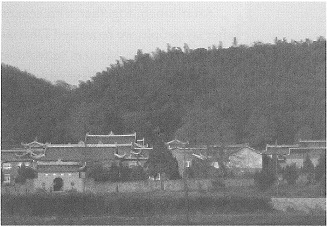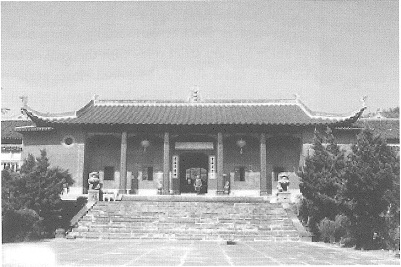|
自從我們決定不上班,就決定一償多年心願,離開美國,去中國參訪寺廟及尋訪善知識。可惜,跟著旅遊團,一路走來,雖覽名山大川、風景名勝,卻見處處都是抽籤問卦、收費騙錢,令我們大失所望。直到有一天,我們離開旅遊團,在大理「感通寺」(臨濟宗),見到一位來探望老師的青年比丘傳輪師,他跟我們說在剛出家時,他也是讀宣公上人的開示錄(簡體字版);他對老和尚非常崇敬,推崇上人是位了不起的偉人。他現在任教於佛學院,他要我們多習經教,深入經藏,必須要有實證才算入門,所謂「通宗不通教,開口便是錯;通教不通宗,兩眼黑矇矇。」
2004年十月底在廈門「南普陀」時,有位比丘建議我們應去江西真如寺,那是虛雲老和尚圓寂的所在。我們進入趙州關山門後,就見大大的平臺,四周都是山,一瓣一瓣如同蓮花瓣,平臺則像蓮花蕊。一進真如寺,就像回到家一樣;這裡農禪並重,是禪風極盛的大叢林,處處清靜,莊嚴香郁,空氣極好,星星也很清亮。那種感覺,就跟我在萬佛城時一樣。
當我們到達那裡時,才知在幾天前剛傳授「三壇大戒」,有三百五十名新戒子才剛離去。該寺平常也有參學的比丘隨時來此朝山及掛單,尤其到了每年禪七(七個七)人更多,由好幾位首座大德,帶領打坐參禪,剋期取證,規矩很嚴;在第三個七時,門就關上,人不得出去了。「真如寺」還保留著傳統的修行方式,自給自足,在洗手間下方有一大片菜園,後面是一大片的茶園,前面是一大片的稻田,我們還看見耕地的水牛。這兒的出家人每天都有很多的工作,工作時認認真真。他們認為:不停的工作,就是不斷的修行;他們很少說話,對經典則非常嫻熟。
真如禪寺 Zhenru Monastery |
 |
我們見到了幾位曾跟隨虛老的和尚,如87年應上人之邀來過萬佛城的海音法師和正知首座。他們親切招呼我們,給我們很多白果、核桃,還有其他水果,如同上人、長輩一般,和我們話家常,談修行。在93歲彌光老和尚的客廳裏,供奉著虛雲老和尚、來果禪師及上人合影的相片,書架內有很多上人的開示錄及上人各類的經典解釋。彌光老和尚在病榻上親切的接見我們,並送我們一本新印刷的《應無所住》。他對我們說,這兩年各地有自然災害,要安好自己的位(不久,印尼、泰國等地真的發生大海嘯)。慧通首座八十幾歲,卻老當益壯,行步有力,還堅持住在般若茅棚,據說他常到五台山領導比丘們打禪七。
在禪堂前有一棵植於唐朝時的千年銀杏樹,每年都結很多的白果;我們去時,大家都在幫忙撿白果。出家人耐性的把掉下的白果泡在水裏,讓皮爛了,然後曬乾,再拿夾子一顆一顆的敲去爛皮,然後再洗再曬;因為白果的皮有毒,一旦手碰到,皮膚就會掉色變白,所以撿時必須有耐性。
真如寺天王寶殿 Palace for Heavenly Kings at Zhenru Monastery |
 |
午齋後,我們和幾位居士在「虛雲紀念館」前向法師請開示。有人請問當如何參話頭?什麼叫「無所住而生其心」?眾中一位年輕比丘,以經典來解釋;他對《楞嚴經》、《金剛經》都非常的熟悉,還謙虛的說當請教老修行,便順手指著一位正在工作,一言不發的中年比丘。一眼望去,那位法師正是工作就是修行,修行就是工作,清清靜靜的僧人;令人一見,敬信之心油然而生。一位看管紀念館的老比丘,幾十年來唯讀一本《妙法蓮華經》(書已被翻得很舊);他每天在做完工(他們的工作量是很大的)後,利用自己的時間,一字一拜《法華經》。他們除了菜園、茶園、稻田要自己種外,三、四月還得採茶,十一月泡製白果;茶葉、白果都是賣的。在後山,我們也看到比丘們自己修路、搬大石頭、清理倒地的枯樹。
除此之外,日常的掃地、煮飯(有時有千人用齋)、煮水、劈柴及燒火,都是比丘們親自動手。在此我們碰到了五位女居士,她們特別請了假,發心到此來服務三天──「真如寺」規定女眾不可住超過三天。她們整整洗曬了上千條棉被,才歡歡喜喜的離去。在此修行的居士也很精進,有一位整夜不倒單,準備出家;一位還到「高旻寺」打七,一位念佛不斷等等。他們都知道「萬佛城」,都知道宣公上人,也都看過上人的書,非常崇拜上人。
待續
|
|
Since we resigned from our jobs, we left the United States for China to fulfill our long-cherished dream to visit temples and to seek good and wise advisors. Unfortunately, we were totally disappointed with the tour. Although it took us to many famous mountains, rivers and scenic sites, we saw too many fortune-tellers and scammers. When we finally left the tour group,we then met a young Bhikshu, Chuan-lun Shi, who was visiting his master in Gan Tong Temple (Lin-ji Lineage). He told us that he also had read the selected teachings of the Venerable Master Hua (in simplified Chinese) shortly after he left home, and had deep admiration and regard for the Venerable Master as a great sage. Dharma Master Chuan-lun was a teacher at a Buddhist Academy and he encouraged us to study more Sutras –– to deeply enter and fathom the treasury of Sutras. He stressed that only by truly practicing the teaching can we enter the gateway of the Buddhadharma. As the saying goes:“ To be skilled in Chan but ignorant in the Dharma, one will err as soon as one speaks; to be learned in the Dharma but unskilled in Chan practice, one will always walk in darkness.”
When we visited Nanputuo (Southern Potola Mountain) Monastery in Xiamen, a Bhikshu suggested that we pay a visit to Zhen-ru [True Suchness] Monastery in Jianxi Province where Venerable Master Xu Yun had entered Nirvana. After entering the mountain gate of Zhao-zhou Guan (Pass of Venerable Zhao-zhou), we saw a huge platform surrounded by mountains that looked like lotus flower petals with the platform itself being in the center. The minute we walked into Zhenru Monastery, we felt at home. Zhenru Monastery is known for its dual practice of farming and Chan. It is a Chan monastery. Its environment, with its tranquility, incense fragrance, fresh air, bright stars and clear sky at night, reminded us of the City of Ten Thousand Buddhas (CTTB).
We were informed, after our arrival, that there had just been a “Threefold Ordination” a few days ago when 350 monks were fully ordained as Bhikshus. The monastery is open to traveling monks who make pilgrimages there, providing them with room and board during their stay. It is especially busy during the annual seven-week Chan Sessions led by several head monks. The monks abide by very strict rules with the goal of becoming enlightened during those 49 days. The door closes at the third session and no one can get out. Zhenru Monastery keeps its traditional style of practice and continues to be a sustainable community. There is a huge vegetable garden below the monastery, a big tea field in the back, and a big rice field in the front. We even saw water buffalos used for farming there. All the monks had a heavy daily workload and they all worked very hard. They believe that working is cultivating. They don’t talk much, but are familiar with the Sutras.
We met with several elder monks who are disciples of Venerable Xu Yun, including Dharma Master Hai Yin (Ocean Sound) and Zheng Zhi (Right Knowledge), the head monk. They had both been invited to the City of Ten Thousand Buddhas in 1987. They gave us a warm welcome and a nice treat of gingko, walnuts and other fruits just the way our Master (Shifu) would have taken care of us. We talked about our life and cultivation.
We also paid a visit to Master Mi Guang who is 93 years old. He has a photo of Venerable Master Xu Yun, Venerable Master Lai Guo and Venerable Master Hua on his altar. There is a large collection of Venerable Master Hua’s teaching and his explanations of many sutras on his bookshelf. Although Ven. Master Mi Guang was not feeling very well, he still received our visit very kindly and gave us a newly published book named
With the Mind Dwelling Nowhere. He told us that there would be a lot of natural disasters during the next two years and asked us to properly situate ourselves. (Soon after our visit, the tsunami hit Indonesia and Thailand). Hui Tong, the head monk, was over 80 years old, yet still strong and healthy. He walked very steadily and continued to live in his thatch-roofed hut. We were told that he frequently goes to Wutai (Five-peaks) Mountain to lead their Chan session.
In front of the Zhenru (True Suchness) Monastery, there is a thousand-year old gingko tree from the Tang Dynasty that yields tons of ginkgoes every year. It was the harvesting season when we were visiting. The monks patiently gathered the gingkoes from the ground and soaked them in water until the skin started to rot. Then the gingkoes were sun dried and peeled clean and then rinsed and dried in the sun again. Because the skin of the gingko is poisonous, people have to be very patient when peeling it, and also have to take great caution not to let their hands come in contact with the skin of the gingko. Otherwise, the area of their hand that comes in contact with it will turn white.
After lunch, together with several other lay people, we requested Dharma from the Dharma Masters in front of the Memorial Hall of Venerable Master Xu Yun. Someone asked how to investigate the
kong-an, or a meditation topic. What is the meaning of “with the mind dwelling nowhere”? One young Bhikshu answered us by referring to the Sutras. He was very familiar with the
Shurangama Sutra and the Vajra Sutra. Being a humble cultivator, he suggested that we consult with an older cultivator, as he pointed to a middle-aged Bhikshu who was quietly working. When we looked over, we noticed that the Dharma Master was a perfect example of how working is cultivation and cultivation is working. He looked peaceful and at ease and instructed us without words. Just by looking at him, we were filled with respect and awe. We were told that the old Bhikshu who managed the Memorial Hall had dedicated several decades of his life to reading and reciting the Lotus Sutra (the Sutra looked very used and old after repeated page flipping). He also bowed to each character over the years during his free time after work. The monastic community had a busy work schedule. Apart from cultivating the vegetable garden, the tea garden and the rice fields, there is a tea harvest in March and April and gingko harvest in November. At that time tea and gingkoes are packaged and sold. During our stay, we also saw some Bhikshus doing road repair, hauling big blocks of stone and clearing a fallen tree.
There are other jobs to be done: sweeping, cooking, boiling water (occasionally, they prepare meals for over a thousand people), chopping wood, and tending the fire. We met five upasikas—lay women who took time from work and came to volunteer for three days. According to the rule of Zhenru Monastery, women can stay in the temple for no more than three days. They finished cleaning over a thousand cotton blankets and left with joy.
The laity in the temple are vigorous in their cultivation. One layperson never lies down to sleep and is preparing to enter the monastic life. One went to Gaoming Temple to attend a seven-day session and one recites Buddha’s name unceasingly. They have all heard of CTTB and the Venerable Master Hua, read his books and have a high regard for him.
To be continued
|